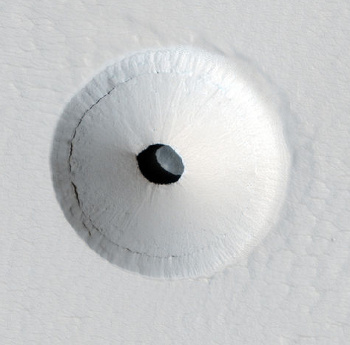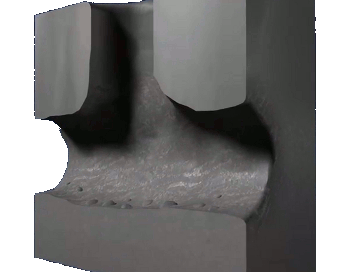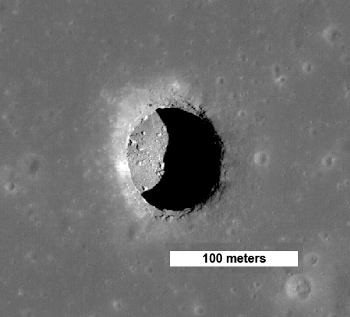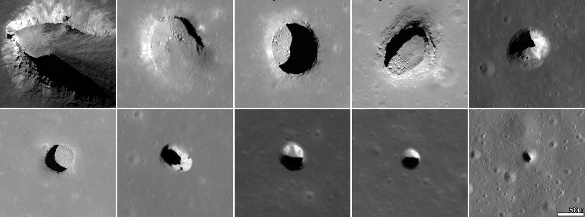Lunar Caves
August 4, 2014
The summer of 1966 saw the release of "
Wild Thing," a
song by the
English musical group,
The Troggs. The song reached number one on the
US record charts, and I always thought that the group's name was derived from
troglodyte, a
cave dweller.
It's likely that many of our
ancestors lived in
trees, an adequate shelter from most
wild animals, but the popular image of early man is that of a
caveman.
Neanderthals and
Cro-Magnons took occasional refuge in
caves. There's
fossil evidence for this, but there certainly weren't enough caves available for everyone. Caves protect
human artifacts from
environmental degradation, so the presence of humans is just more likely to be found in caves.
Most caves are formed by the action of
water, and some caves are formed by the
dissolution of
limestone by
acidic groundwater. Another category of cave is the
lava tube, formed by flowing
lava moving beneath the surface of hardened lava flow. When the lava flow stops, a
hollow tube remains. As I wrote in a
previous article (The Caves of Mars, July 23, 2010), lava tubes exist, also, on
Mars.
The
Thermal Emission Imaging System (THEMIS), a
camera on
NASA's Mars Odyssey orbiter, detected evidence of one in the area of the Martian
volcano,
Pavonis Mons.[1] An image showed an unusually black dot indicative of a
hole with steep, vertical
walls. This supposed "
skylight" entrance to a lava tube is estimated to be about 600
feet in
diameter, and at least 380 feet deep.[1]

Skylight of a lava tube at Pavonis Mons on Mars.
This photo was taken with the HiRISE camera of the Mars Reconnaissance Orbiter.
(NASA/Jet Propulsion Laboratory/University of Arizona photo, via Wikimedia Commons.)
Such lava tubes could be important to exploration of Mars. On
Earth, our
atmosphere and
magnetosphere shield us from
cosmic radiation and
micrometeorites, but such protection is not available for Martian explorers. That's where Martian lava tubes would have a role. They would offer shielding from these dangers, and they would also have a more even
temperature than the
planet's surface.[1-2]
Such lava tube protection is available, also, on the
Moon. There are many more such lava tubes with collapse pits on the Moon, as imaging by the
Lunar Reconnaissance Orbiter's Narrow Angle Camera has shown.[3-5] The Moon is a big place, so many of these collapse pits were identified by a
computer algorithm that automatically scanned the
high-resolution images.[3-4]

Cross section of a lava vent with a collapsed opening.
(Sill image from a YouTube video by NASA's Goddard Space Flight Center/D. Gallagher.)[5)]
So far, more than 200 pits have been found. These range in size from about five
meters in diameter to more than 900 meters.[4] The first three were found in images from the
Japanese spacecraft, Kaguya. The majority of the pits were found the
melt ponds of
geologically young "
Copernican"
craters, which are less than a billion years old.[4] These pits averaged sixteen meters in diameter and seven meters in depth.[3]
The lunar pits appear in large craters, where lava was formed from the heat of
meteor impact, and in the
lunar maria, which were formed by extensive lava flows. Although the pits could form by a roof collapse from nearly
vibration, such as a meteorite impact, the pits are more likely to have formed from direct meteor impact. The pits are significantly younger than their host materials.[3]
If the lunar lava tubes are anything like those on Earth, they could extend for miles underground and the collapse pits could act as access points for extensive
habitats.[3] Some pits have overhangs, so they may connect to larger voids.[3] The pits also offer a look into the subsurface
geology. Says
Robert Wagner, a member of the
Arizona State University School of Earth and Space Exploration,
"The mare pits in particular would be very useful for understanding how the lunar maria formed. We've taken images from orbit looking at the walls of these pits, which show that they cut through dozens of layers, confirming that the maria formed from lots of thin flows, rather than a few big ones. Ground-level exploration could determine the ages of these layers, and might even find solar wind particles that were trapped in the lunar surface billions of years ago."[4]
Wagner, who is the lead
author of the
paper in
Icarus that describes this
research, developed the image analysis algorithm.[4]

A high-Sun view of the Mare Tranquillitatis pit crater. North is up, and the scale is shown.
(NASA/GSFC/Arizona State University image, cropped for clarity.)
Since only forty percent of the Moon has been imaged by the Lunar Reconnaissance Orbiter with lighting appropriate for the image analysis algorithm, there are likely more pits to be found.[4] Near the polar areas, the
angle of the Sun is such that the image analysis algorithm won't work. In those regions, it's hard to distinguish pits from impact craters.[4]

A montage of images of mare pits and highland pits. These were taken with the LRO spacecraft, and each image is about 220 meters wide. (NASA/Goddard Space Flight Center/Arizona State University image, cropped for clarity.)
Says Wagner,
"The ideal follow-up, of course, would be to drop probes into one or two of these pits, and get a really good look at what's down there.. Pits, by their nature, cannot be explored very well from orbit -- the lower walls and any floor-level caves simply cannot be seen from a good angle. Even a few pictures from ground-level would answer a lot of the outstanding questions about the nature of the voids that the pits collapsed into."[4]
References:
- Robert Burnham, "Middle-school project discovers cave skylight on Mars," School of Earth and Space Exploration, Arizona State University, June 17, 2010.
- Ray Villard, "Subterranean Living May Await Moon and Mars Colonists," Discovery Magazine Online, July 18, 2010.
- Robert V. Wagner and Mark S. Robinson, "Distribution, formation mechanisms, and significance of lunar pits," Icarus, vol. 237 (July 15, 2014), pp. 52-60.
- Bill Steigerwald, "Lunar Pits Could Shelter Astronauts, Reveal Details of How 'Man in the Moon' Formed," NASA Goddard Space Flight Center Press Release, July 17, 2014.
- D. Gallagher, NASA's Goddard Space Flight Center, Images from NASA's LRO spacecraft of various lunar pits, YouTube video.
- NASA LRO website
Permanent Link to this article
Linked Keywords: Wild Thing; song; English; musical group; The Troggs; Billboard Hot 100; US record chart; troglodyte; cave dweller; ancestor; tree; wild animal; caveman; Neanderthal; Cro-Magnon; cave; fossil; archaeology; human artifact; environment; environmental; decomposition; degradation; water; dissolution; limestone; acid; acidic; groundwater; lava tube; lava; hollow tube; Mars; Thermal Emission Imaging System (THEMIS); camera; NASA; Mars Odyssey orbiter; volcano; Pavonis Mons; hole; wall; skylight; foot; diameter; HiRISE camera; Mars Reconnaissance Orbiter; Jet Propulsion Laboratory; University of Arizona; Wikimedia Commons; Earth; atmosphere of Earth; magnetosphere; cosmic ray; cosmic radiation; micrometeoroid; micrometeorite; temperature; planet; Moon; Lunar Reconnaissance Orbiter; Narrow Angle Camera; computer algorithm; high-resolution image; cross section; YouTube video; Goddard Space Flight Center; meter; Japanese spacecraft, Kaguya; melt pond; lunar geologic timescale; Copernican period; impact crater; meteor impact; lunar mare; lunar maria; vibration; habitat; geology; Robert Wagner; Arizona State University; School of Earth and Space Exploration; orbit; author; scientific literature; paper; Icarus; research; Mare Tranquillitatis; solar zenith angle; photomontage; montage; space probe.